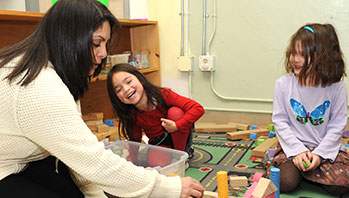- laundry basket
- various hats made from different materials (knit cap, plastic shower cap, rain hat, baseball cap, hard hat, etc.)
- absorb
- laundry
- wet
MA Standards:
Speaking and Listening/SL.PK.MA.1a: Observe and use appropriate ways of interacting in a group (e.g. taking turns in talking, listening to peers, waiting to speak until another person is finished talking, asking questions and waiting for an answer, gaining the floor in appropriate ways).
Head Start Outcomes:
Social Emotional Development/Self-Regulation: Follows simple rules, routines, and directions.
Language Development/Receptive Language: Attends to language during conversations, songs, stories, or other learning experiences.
Logic and Reasoning/Reasoning and Problem Solving: Classifies, compares, and contrasts objects, events, and experiences.
Science Knowledge/Scientific Skills and Method: Observes and discusses common properties, differences, and comparisons among objects.
PreK Learning Guidelines:
English Language Arts/Language 1: Observe and use appropriate ways of interacting in a group (taking turns in talking; listening to peers; waiting until someone is finished; asking questions and waiting for an answer; gaining the floor in appropriate ways).
Science and Technology/Inquiry Skills 2: Make predictions about changes in materials or objects based on past experience.
EEC Infant and Toddler Guidelines:
PW50.: The older toddler engages in a variety of physical activities.
Play Together: Laundry Hat Toss

© Commonwealth of Massachusetts, Department of Early Education and Care (Jennifer Waddell photographer). All rights reserved.
ELA Focus Skills: Compare and Contrast, Gross Motor Skills, Hand-Eye Coordination, Sorting and Classifying, Fine Motor Skills
Educator Prep: Use masking tape to mark the spot on the floor where children will stand to toss hats into the laundry basket.
Tell children they are going to play a game called “Laundry Basket Toss.” Set up a laundry basket near the pile of hats. Say, Mrs. McNosh has many silly things in her wash, but she has some things we wash, too, such as socks, dresses, and hats. Ask children to stand if they wore a hat to school today. Have them retrieve the hat and show it to the group. Ask, Do you put your hat in the laundry to be washed? Do you put it in the dryer or hang it out on the clothesline to dry? What happens to the water that was in the hat when it was wet?
Invite children to look at the pile of hats. Talk about how the materials the hats are made of are alike or different. Ask, What hats do you think will go in the laundry? What hats do you think will absorb water? Why do you think that? Record children’s responses and then say, Let’s play a hat game!
- Tell children to work in pairs to find a hat that they think will absorb water and can go in the laundry.
- Once they have found a hat, let children take turns throwing the hat into a laundry basket a few feet away.
Take It Further: You may want to have children explore placing the hats in a tub of water to observe which hats absorb water. Discuss how many of the hats that do not absorb water are also the hats that don’t go in the laundry (hard hat, shower cap, etc.) Talk about the materials they are made of. Challenge children to think of other things made of those materials that would not go in the laundry.
